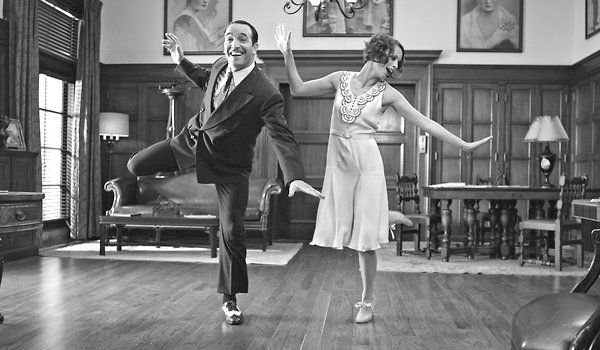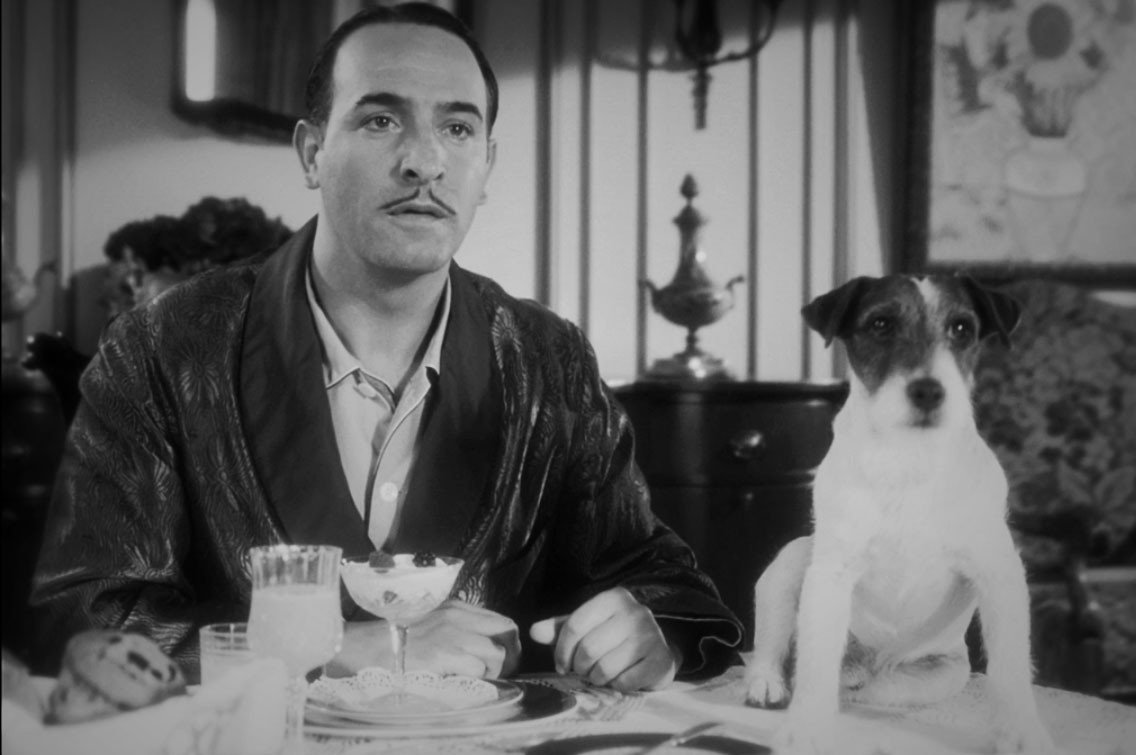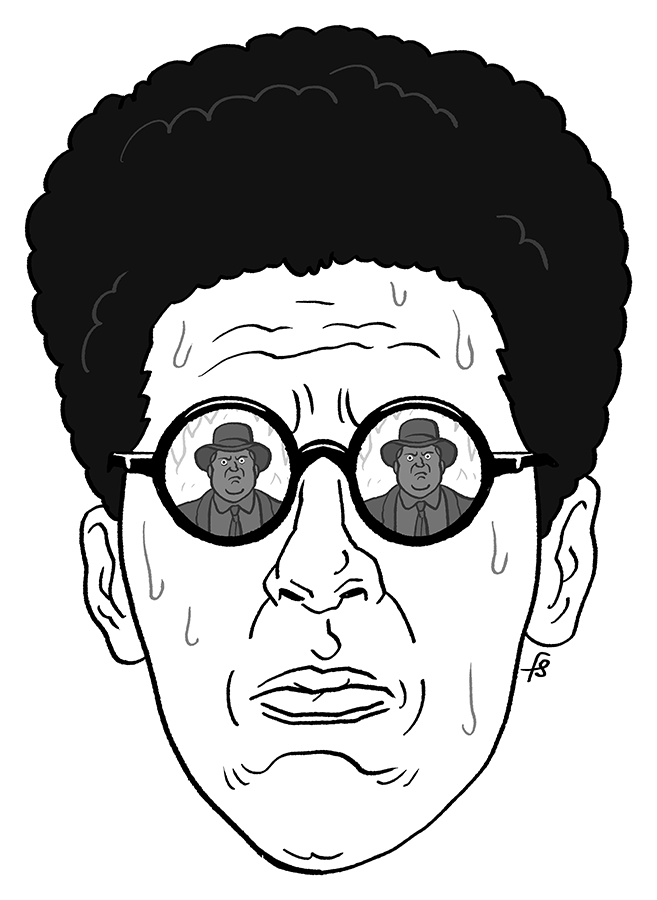2011's The Artist Is a True Forgotbuster; It Has All But Disappeared Culturally Despite Boffo Box Office and Some Very Big Academy Award Victories
Writer-director Michel Hazanavicius’ 2011 blockbuster The Artist, which won the Academy Award for Best Picture in addition to Best Director and Best Actor (Jean Dujardin), is famously a rapturous, swooning tribute to the heyday of silent film shot entirely in black and white with inter-titles and a minimum of talking, noise and music. It’s not quite a silent movie but it’s not quite a talkie either but rather an exceedingly late, excessively celebrated example of a curious breed of movie known as the semi-talkie.
But Hazanavicius’s gorgeously mounted ode to the cinema of yesteryear does not limit itself to silent cinema when it comes to inspiration. On the contrary, The Artist is only slightly less of a remake of A Star Is Born than the one that won star Lady Gaga an Academy Award for Best Song. But the wildly derivative comedy melodrama seems equally inspired by another of the all-time great talkies in Singing in the Rain.
Imagine Singing in the Rain as an actual silent film (mostly) in which the dashing hero greets the dawning of sound film and the impending death of silent movies with angry, self-serious defiance and a self-defeating refusal to evolve with the times and you have a good sense of The Artist is up to, plot-wise and thematically.
The Artist opens in 1927 with impossibly dashing, charismatic protagonist George Valentin (Jean Dujardin) on top of the world, showboating for his beloved public at the premiere of his latest smash-hit silent melodrama. The world loves our narcissistic hero but not quite as much as he loves himself.
As a natural born movie star seemingly born in a tuxedo and tails, Jean Dujardin’s silent screen matinee idol glides deliriously through a charmed life. As a titan of the silent screen he does more acting with his wildly expressive eyes and eyebrows than lesser actors accomplish with their entire face and body.
George is in his element, vamping it up alongside a dog (breakout star Uggie, a very, very good boy) so adept at physical comedy and melodrama that he’s the Charlie Chaplin and the Lilian Gish of the canine set. While signing autographs outside for fans, George bumps into Peppy (Bérénice Bejo), an unusually pure representation of an old time film archetype: the unknown so dazzling and undeniable that the very heavens themselves angrily demand that she assume her righteous destiny and become not just a star but America’s sweetheart, a new “It” girl with serious flapper energy.
The camera doesn’t just like Peppy: it adores her with obsessive, passionate intensity. In a very A Star is Born dynamic, George unknowingly represents a silent cinematic past that is about to be put out to pasture as obsolete and outdated while Peppy embodies a glorious, albeit scary and threatening future where movie stars don’t just smile and emote but sing, dance, quip and win over the public with their voices as well as their beautiful faces.
George is on the wrong side of history, convinced that sound is nothing but a passing fad the moviegoing public will soon tire of and return to their beloved silent stars. He doubles down on that unfortunate conviction that a future exists for silent film, and by extension for him as a silent film star, by making a silent movie in 1929 that needs to be a huge success in order to stop his slide into the gutter but instead proves a predictable disaster, seemingly beloved only by Peppy, who never stops believing in the old ham even after he stops believing in himself and she rockets to super-stardom.
Needless to say, George does not handle the death of silent film, and with it the demise of his once thriving career, with dignity or grace. Failure transforms him into a Charles Foster Kane-like figure, too stubborn to accept that the world is no longer interested in what he’s selling.
Hazanavicius’ Academy Award-festooned throwback is a breezy, effervescent delight when chronicling George’s time on top. It benefits from a light touch and sparkling, ebullient wit that begins to dissipate once inventive, cleverly conceived and executed physical comedy gives way to gloomy melodrama when George goes from hero to zero, from world-beating alpha male to broke sad sack just barely getting by in a world that once elevated him to the level of a God but now seemingly wants nothing to do with him or his floundering career.
Our hero spends a lot of The Artist marinating in self-pity as the world he knew ends unceremoniously, giving way to a new style of film that he not only does not understand or appreciate, but sees as inherently inauthentic and distasteful. Not even an actor as charismatic as Dujardin can make gloomy myopia and moping appealing or sympathetic.
The Artist needs Peppy and her rollicking energy as much, if not more, than George does.
In The Artist, Bérénice Bejo has the enviable problem of being, if anything, too irresistible, to the point that any moment that she’s not onscreen feels like a terrible waste. The gamine Gallic pixie has got star-power up the wazoo but that’s not all. She also has moxie, hustle, pizzazz, glitter, glamour and every other magical quality that separates movie stars from mere mortals.
What Bejo does not have, however, is an actual character with any depth or dimension to play. For all of her magnetism, Bejo’s character has no real agency or inner drive. She exists not to pursue her own happiness but rather to reconnect a depressed sad sack with his long-lost lust for life and joie de vivre, to end his extended depression and set him back on the road to redemption and salvation, even if it means risking some of her own extraordinary success in the process.
Bejo and Dujardin have such explosive chemistry that the film’s decision to separate them for long stretches in order to focus on the title character wallowing in misery feels perverse, not to mention counter-productive.
After being a real Pierre Moper for much of the film, George is finally roused from his boozy, bleary depression, apathy and self-pity by the unselfish love and belief of pure-hearted Peppy, who races to keep him from ending his life with a strategically placed bullet and gives him the happy ending that ensures that the film ends on a crowd-pleasing moment of uplift and musical comedy rather than tragedy.
The Artist is cute. It’s clever. The dog is wonderful! It looks fantastic, a delirious fantasy of our collective cinematic past. Bejo and Dujardin burn up the screen. Yet The Artist’s purposeful slightness, that giddy, fizzy, dizzy sense that it’s all ultimately just a gorgeous goof, that provides much of its old-fashioned charm also makes it an odd choice for the most prestigious honor in all of film in the Best Picture Academy Award.
Then again the movies that tend to dominate at the Academy Awards are generally not the best or most worthy films but rather movies that flatter the egos and narcissism of movie people forever nostalgic for their own breathlessly idealized, romanticized past. On that level, it’s very easy to see why The Artist’s strong showing at the Oscars was not just predictable but downright inevitable.
The Artist couldn’t help but remind me of a column I wrote for The Dissolve called Forgotbusters about movies that topped the box-office at the time of their release but have subsequently been mostly forgotten. For all of its success, which includes Oscar wins for Best Picture, Best Actor and Best Director I can’t remember the last time someone brought it up in a context other than regrettable best picture winners.
The Artist won very big at the time of its release in pretty much every conceivable way. That winning streak ended sharply somewhere along the line as a forgetful public quickly lost interest in it and its gossamer Gallic charm.
Would you like to read a MASSIVE book about movies like The Artist, only more American!?! Then check out the Kickstarter for The Happy Place’s next book, The Fractured Mirror: Nathan Rabin’s Happy Place’s Definitive Guide to American Movies About the Film Industry here: https://tinyurl.com/2p8dn936
The Joy of Trash, the Happy Place’s first non-"Weird Al” Yankovic-themed book is out! And it’s only 16.50, shipping, handling and taxes included, 30 bucks for two books, domestic only!
PLUS, for a limited time only, get a FREE copy of The Weird A-Coloring to Al, Felipe Sobreiro and my “Weird Al” Yankovic-themed coloring. book when you buy any other book in the Happy Place store! That’s a 10.50 value for free!
Buy The Joy of Trash, The Weird Accordion to Al and the The Weird Accordion to Al in both paperback and hardcover and The Weird A-Coloring to Al and The Weird A-Coloring to Al: Colored-In Special Edition signed from me personally (recommended) over at https://www.nathanrabin.com/shop
Or you can buy The Joy of Trash here and The Weird A-Coloring to Al here and The Weird Accordion to Al here
Help ensure a future for the Happy Place during an uncertain era AND get sweet merch by pledging to the site’s Patreon account at https://www.patreon.com/nathanrabinshappyplace We just added a bunch of new tiers and merchandise AND a second daily blog just for patrons!
Alternately you can buy The Weird Accordion to Al, signed, for just 19.50, tax and shipping included, at the https://www.nathanrabin.com/shop or for more, unsigned, from Amazon here.
I make my living exclusively through book sales and Patreon so please support independent media and one man’s dream and kick in a shekel or two!








